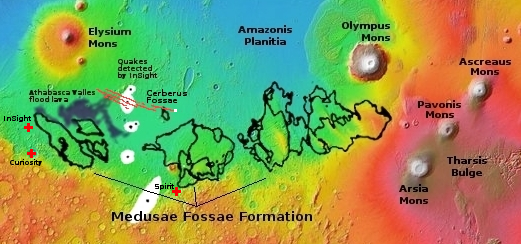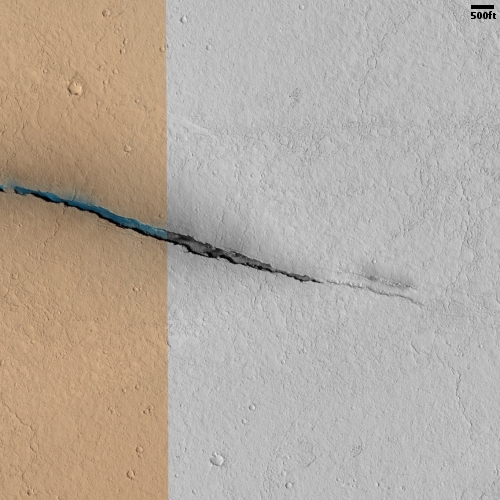The very end of an 800-mile-long Martian canyon
Cool image time! While most geeks interested in Mars are familiar with Valles Marineris, the largest canyon in the solar system, Mars has other large canyons that while not a big are impressive in their own right. The picture to the right, rotated, cropped, and reduced to post here, shows us the very very end of one such canyon. Taken on April 19, 2022 by the high resolution camera on Mars Reconnaissance Orbiter (MRO), it shows the easternmost spot where Cerberus Fossae begins. From here, this narrow fracture-caused canyon extends another 800 miles to the west, sometimes splitting into two or three parallel cracks, but always oriented in the same direction, slightly north of due west.
The overview map below provides the context and wider view.

The white dot at the very eastern end of Cerberus Fossae marks the location of today’s image. The parallel red lines to the west mark the extend of the canyon itself. Notice how one of the earthquakes detected by InSight’s seismometer occurred almost at the canyon’s midpoint.
Cerberus was not formed from water or lava flow. Instead, it formed when the ground cracked, from either upward or spreading pressure pulling the sections apart. Geologists call the features produced by this process grabens, and Cerberus is a doozy, one of the longest known.
It is also relatively young. The lava that flooded the plains it cuts across flowed first, then hardened. This frozen lava then later cracked, producing the canyon.
And yet, newer volcano events did follow, though nothing in at least the last 50,000 years. Those young volcanic events along Cerberus’ length resemble the dark streak just to the north of the canyon’s very end (see the cool image here for an example). The streaks in today’s image however could just as easily be the result of blowing dust from the prevailing winds.
This picture nicely illustrates the abrupt steepness of Cerberus Fossae. As the canyon widens and deepens, its walls remain consistently vertical. Easy access to its bottom is rarely available. This end point provides a more accessible entrance point, but even here the drop is steep and suddenly.
The color difference also highlights this. The orange suggests dust on the surrounding plateau. The blue suggests water ice at the canyon’s base, suggesting a very different climate. At only 6 degrees north latitude ice here would be a somewhat significant find, as no surface ice has so far been detected at latitudes this low.
On Christmas Eve 1968 three Americans became the first humans to visit another world. What they did to celebrate was unexpected and profound, and will be remembered throughout all human history. Genesis: the Story of Apollo 8, Robert Zimmerman's classic history of humanity's first journey to another world, tells that story, and it is now available as both an ebook and an audiobook, both with a foreword by Valerie Anders and a new introduction by Robert Zimmerman.
The print edition can be purchased at Amazon or from any other book seller. If you want an autographed copy the price is $60 for the hardback and $45 for the paperback, plus $8 shipping for each. Go here for purchasing details. The ebook is available everywhere for $5.99 (before discount) at amazon, or direct from my ebook publisher, ebookit. If you buy it from ebookit you don't support the big tech companies and the author gets a bigger cut much sooner.
The audiobook is also available at all these vendors, and is also free with a 30-day trial membership to Audible.
"Not simply about one mission, [Genesis] is also the history of America's quest for the moon... Zimmerman has done a masterful job of tying disparate events together into a solid account of one of America's greatest human triumphs."--San Antonio Express-News
Cool image time! While most geeks interested in Mars are familiar with Valles Marineris, the largest canyon in the solar system, Mars has other large canyons that while not a big are impressive in their own right. The picture to the right, rotated, cropped, and reduced to post here, shows us the very very end of one such canyon. Taken on April 19, 2022 by the high resolution camera on Mars Reconnaissance Orbiter (MRO), it shows the easternmost spot where Cerberus Fossae begins. From here, this narrow fracture-caused canyon extends another 800 miles to the west, sometimes splitting into two or three parallel cracks, but always oriented in the same direction, slightly north of due west.
The overview map below provides the context and wider view.

The white dot at the very eastern end of Cerberus Fossae marks the location of today’s image. The parallel red lines to the west mark the extend of the canyon itself. Notice how one of the earthquakes detected by InSight’s seismometer occurred almost at the canyon’s midpoint.
Cerberus was not formed from water or lava flow. Instead, it formed when the ground cracked, from either upward or spreading pressure pulling the sections apart. Geologists call the features produced by this process grabens, and Cerberus is a doozy, one of the longest known.
It is also relatively young. The lava that flooded the plains it cuts across flowed first, then hardened. This frozen lava then later cracked, producing the canyon.
And yet, newer volcano events did follow, though nothing in at least the last 50,000 years. Those young volcanic events along Cerberus’ length resemble the dark streak just to the north of the canyon’s very end (see the cool image here for an example). The streaks in today’s image however could just as easily be the result of blowing dust from the prevailing winds.
This picture nicely illustrates the abrupt steepness of Cerberus Fossae. As the canyon widens and deepens, its walls remain consistently vertical. Easy access to its bottom is rarely available. This end point provides a more accessible entrance point, but even here the drop is steep and suddenly.
The color difference also highlights this. The orange suggests dust on the surrounding plateau. The blue suggests water ice at the canyon’s base, suggesting a very different climate. At only 6 degrees north latitude ice here would be a somewhat significant find, as no surface ice has so far been detected at latitudes this low.
On Christmas Eve 1968 three Americans became the first humans to visit another world. What they did to celebrate was unexpected and profound, and will be remembered throughout all human history. Genesis: the Story of Apollo 8, Robert Zimmerman's classic history of humanity's first journey to another world, tells that story, and it is now available as both an ebook and an audiobook, both with a foreword by Valerie Anders and a new introduction by Robert Zimmerman.
The print edition can be purchased at Amazon or from any other book seller. If you want an autographed copy the price is $60 for the hardback and $45 for the paperback, plus $8 shipping for each. Go here for purchasing details. The ebook is available everywhere for $5.99 (before discount) at amazon, or direct from my ebook publisher, ebookit. If you buy it from ebookit you don't support the big tech companies and the author gets a bigger cut much sooner.
The audiobook is also available at all these vendors, and is also free with a 30-day trial membership to Audible.
"Not simply about one mission, [Genesis] is also the history of America's quest for the moon... Zimmerman has done a masterful job of tying disparate events together into a solid account of one of America's greatest human triumphs."--San Antonio Express-News



Looks like a crack in the drywall. A few quadrillion gallons of mud will take care of that.
Looking closer at those images, it looks like a worm trail out of Herbert’s Dune.
Why hasn’t something so narrow not filled up with dust yet>
We’ve seen this before: https://static.wikia.nocookie.net/flinstones/images/b/be/Grand_Canyon.png/revision/latest?cb=20211127093924